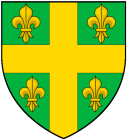





Devices and Badges
originally published in January 2004, written by Nigel, H.E. (reprinted from the heraldry e-list)
What's the difference?
There are no stylistic differences between Devices and Badges other than that Badges may be "fieldless" or "tinctureless". "Fieldless" means that the badge is a unified whole unto itself (think about the three feathers of the Crown Prince of England), and may be placed on any field you want. "Tinctureless" is reserved to the Imperial Crown and its agents, and is used for things like wax seals, that can have no specified tincture.
So, beyond that, there's no stylistic difference, officially. I would recommend that, if you are considering a badge, that you come up with something that is both simple and a unified whole. A badge should be simple, above all else. You're going to replicate this thing a heck of a lot more than your arms, so you'd better be prepared to make something easy.
Some people (like me) preserve their history in their badges. When I changed my persona and my name, I changed my arms as well. I kept my old arms as a badge; they're still mine, after all!
What to do with your badge
The badge-on-the-belt (the "belt favour") is a post- period concept introduced by the SCA - not period.
Badges can be displayed in any shape; the roundel is the most common, but is by no means restricted to that. Even a shield shape is OK. There's no size restriction, either. However, if you are not armigerous in your own right, you may not display any heraldry whatsoever. The only exception to this is your Crown granting you the specific right to do so. This is usually accomplished by the Crown granting you the title of Lord or Lady. If you are the head of an Estate, you are not armigerous in your own right and may only display the arms of your Estate.
If you are armigerous in your own right, but not a Knight, you may not wear your arms on your person in anything larger than 6" on its longest edge. If it's in a shield shape, the shield is no longer than 6". You may not let anyone else wear your badge, but you may place your badge on anything you wish.
If you are a Knight, you may wear a tabard with your arms on it. If you are a 2nd Level Knight, you additionally have the Right of Livery. Now you can go nuts with it, and put your badge on your people as well as your stuff.
What kind of stuff gets heraldic display?
The three feathers badge is found everywhere on the PoW's stuff. His estate in Cornwall has embossed medallions with it on every wall section, above every door, on every conceivable surface. If you saw the special on His Royal Highness' organic farming co-op on PBS a few years ago, they showed his estate with all that heraldry everywhere.
Chair. The back of your camp chair is a perfect place. If it's your personal chair that only you sit in, then put your Arms on it. If it's just part of your household stuff for general use by your family and retainers, then put your badge on it.
Cup & plate. Another great place. If it's your cup that nobody else would dream of drinking out of, put your arms on it. Same for your plate - wouldn't it look cool to have your arms enameled onto your plate?
Banner. Your arms, of course. This includes your battle shield, as well as your list-tree shield. If your retainers fight as a unit, (and you're a K2) then make them all matching shields with your badge on it.
Livery. Throw them all into matching tabards, with or without your badge, and you've got instant group identification. It's a great way to make new members of your household feel part of the group.
Herald's tabard. If you want to hire a personal herald, then you should have a nifty herald's tabard with your arms on it for him to wear. This is also a Liveried Right.
Squire's Belt. This is one place where tradition is exceedingly strong. It's the one place where the Knight's arms are permissible outside his person. The very tongue of the belt is a great place to put your arms. When introducing the new squire to the populace, the Knight says, "Treat him as you would treat me". This seems to be the underlying mindset behind this Tradition - when you are talking to someone's squire, it's as if you are talking to them. Kind of the same way you deal with a tabarded herald.
Other stuff. Your badge goes on your sewing
basket, your first-aid kit, your armor repair kit, your
tourney chest, your stuff. Experiment, and do research.
The illuminations have many examples of heraldic
display for us to look at.
 ";
include($_SERVER['DOCUMENT_ROOT'] . '/_include/footer.php');
?>
";
include($_SERVER['DOCUMENT_ROOT'] . '/_include/footer.php');
?>